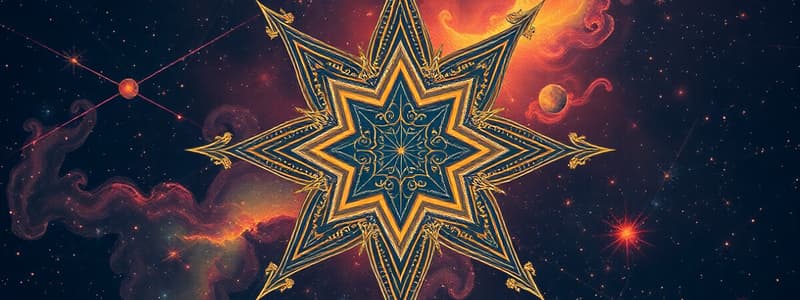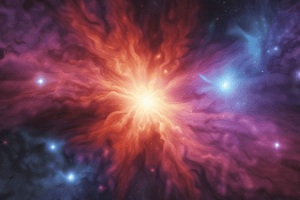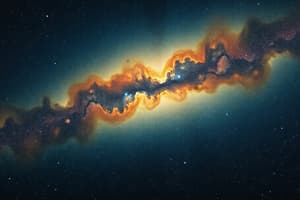Podcast
Questions and Answers
Which of the following best describes the relationship between a star's color and its temperature?
Which of the following best describes the relationship between a star's color and its temperature?
- White stars are the hottest, while yellow stars are the coolest.
- Yellow stars are the hottest, while white stars are the coolest.
- Blue stars are the hottest, while red stars are the coolest. (correct)
- Red stars are the hottest, while blue stars are the coolest.
Why do stars appear to twinkle when viewed from Earth?
Why do stars appear to twinkle when viewed from Earth?
- Earth's atmosphere is always moving and changing, causing the starlight to bend and scatter. (correct)
- Stars emit light in an irregular pattern, causing fluctuations in brightness.
- The distance between Earth and the stars varies, causing fluctuations in brightness.
- The stars are actually flashing on and off.
What triggers the beginning of the protostar stage in the life cycle of a star?
What triggers the beginning of the protostar stage in the life cycle of a star?
- The nuclear fusion of hydrogen into helium.
- The gravitational pull on a cloud of gas and dust, causing it to spin and heat up. (correct)
- The ejection of gas layers from a dying star.
- The explosion of a nearby supernova.
What is the primary factor that determines whether a star will become a red giant or a red supergiant?
What is the primary factor that determines whether a star will become a red giant or a red supergiant?
What event marks the end of a massive star's life, leading to the formation of either a neutron star or a black hole?
What event marks the end of a massive star's life, leading to the formation of either a neutron star or a black hole?
What is the likely outcome for a star with a mass similar to that of our Sun?
What is the likely outcome for a star with a mass similar to that of our Sun?
What is the primary source of energy that fuels stars during their main sequence stage?
What is the primary source of energy that fuels stars during their main sequence stage?
What is a brown dwarf?
What is a brown dwarf?
What is a planetary nebula?
What is a planetary nebula?
What is unique about black holes compared to other objects in space?
What is unique about black holes compared to other objects in space?
What is the name of the supermassive black hole located at the center of the Milky Way galaxy?
What is the name of the supermassive black hole located at the center of the Milky Way galaxy?
How does a star's life cycle primarily affect the composition of the universe?
How does a star's life cycle primarily affect the composition of the universe?
If a star suddenly increases in brightness by a factor of a million and then gradually fades, what event has likely occurred?
If a star suddenly increases in brightness by a factor of a million and then gradually fades, what event has likely occurred?
During which stage of a Sun-like star's life cycle does it eject its outer layers, forming a planetary nebula?
During which stage of a Sun-like star's life cycle does it eject its outer layers, forming a planetary nebula?
Which color are the hottest stars?
Which color are the hottest stars?
What is a nebula?
What is a nebula?
What is the relationship between stars and air?
What is the relationship between stars and air?
What happens to the outer shell of a star in its cooling or explosive stage?
What happens to the outer shell of a star in its cooling or explosive stage?
What happens when stars use all the hydrogen in their core?
What happens when stars use all the hydrogen in their core?
How long can small stars live for?
How long can small stars live for?
Flashcards
Stars
Stars
Giant balls of hot gas, mostly hydrogen, undergoing continuous changes.
Star Color
Star Color
Indicates a star's temperature. Blue stars are the hottest, red stars are the coolest.
Brown dwarf
Brown dwarf
A 'failed star' that lacks sufficient mass for nuclear fusion.
Nebula
Nebula
Signup and view all the flashcards
Protostar
Protostar
Signup and view all the flashcards
Main Sequence Star
Main Sequence Star
Signup and view all the flashcards
Red Giant
Red Giant
Signup and view all the flashcards
Red Supergiant
Red Supergiant
Signup and view all the flashcards
Planetary Nebula
Planetary Nebula
Signup and view all the flashcards
White Dwarf
White Dwarf
Signup and view all the flashcards
Supernova
Supernova
Signup and view all the flashcards
Neutron Star
Neutron Star
Signup and view all the flashcards
Black Hole
Black Hole
Signup and view all the flashcards
Study Notes
- Stars are giant, hot balls of gas, mostly hydrogen, with some helium and trace elements.
- A star's life cycle ranges from a few million to trillions of years, with properties evolving over time.
Colors of Stars
- Star color indicates temperature: red stars are coolest, followed by yellow, white, and blue stars which are the hottest.
- Brown dwarfs are "failed stars" lacking the mass for core nuclear fusion.
- Stars appear round like the Sun, but their distance affects brightness.
- Starlight bends and scatters in Earth's atmosphere, causing stars to twinkle.
Life Cycle of a Star
- Stars undergo birth, growth, life changes, and eventual death.
Nebula and Protostar Stage
- Nebulae, giant clouds of gas and dust, are stellar birthplaces.
- Some nebulae form from dying star explosions (supernovae), while others are "star nurseries".
- Gravity pulls gas (mainly hydrogen) into a spinning cloud, increasing atom collisions and generating heat.
- Nuclear fusion begins as the cloud heats, resulting in a glowing protostar.
- Protostars need to reach 27 million degrees Fahrenheit to complete this stage.
- As a protostar collapses, a hot, dense core forms, gathering gas and dust.
- Remaining dust may form planets, asteroids, or comets.
Main Sequence Star Stage
- Nuclear reactions start once a protostar is hot enough.
- Stars fuse hydrogen into helium in their cores, becoming main sequence stars.
- Star color depends on its temperature at this stage.
- Stars can remain in this stage for thousands to billions of years.
- Stars like the Sun take about 50 million years to mature from collapse to adulthood.
Giant Stage
- The next life cycle stage depends on the size of the main sequence star.
- Smaller stars' paths diverge from larger ones at this point.
- Smaller stars become red giants after billions of years, as nuclear reactions slow, cooling, reddening, and expanding the star.
- Larger stars become supergiants, growing a thousand times bigger than the Sun as nuclear reactions slow.
Cooling or Explosive Stage
- Energy and heat decrease, and stars lose their outer shells in the giant stage.
- Smaller stars that have fused all core hydrogen end nuclear reactions.
- Small stars live over 10 billion years, ejecting outer layers over 10,000 years, leaving a hot white dwarf core.
- White dwarf radiation causes ejected gas to glow, forming a planetary nebula.
- Massive stars become red supergiants and explode as supernovae.
- Supernovae leave behind neutron stars, black holes, or nothing at all.
- A supernova can briefly outshine its galaxy before fading, leaving a neutron star or black hole surrounded by hot gas.
Black Holes
- Black holes are areas where gravity is so strong that even light cannot escape.
- They aren't holes, but places where matter is squeezed into a small space, often during a star's death.
- Black holes are invisible, but space telescopes can find them.
- Smallest black holes may be atom-sized, but with a mountain's mass.
- Stellar black holes can have 20 times the Sun's mass.
- Supermassive black holes have over a million times the Sun's mass, found at galaxy centers.
- Sagittarius A, at the Milky Way's center, has 4 million solar masses.
- Black holes don't "eat" stars, planets or moons, and are not a threat to Earth and the solar system.
- The Sun isn't big enough to become a black hole.
Studying That Suits You
Use AI to generate personalized quizzes and flashcards to suit your learning preferences.




